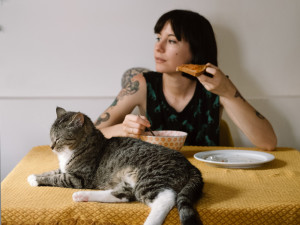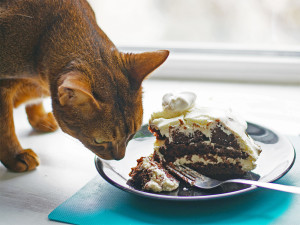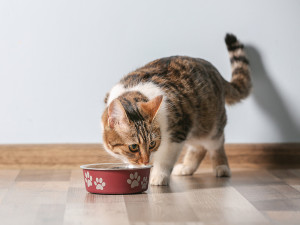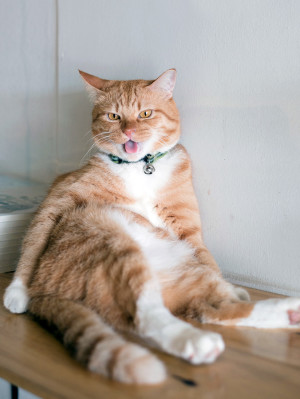How Many Cat Treats Is Too Many?
It can be hard to resist their powers of persuasion...
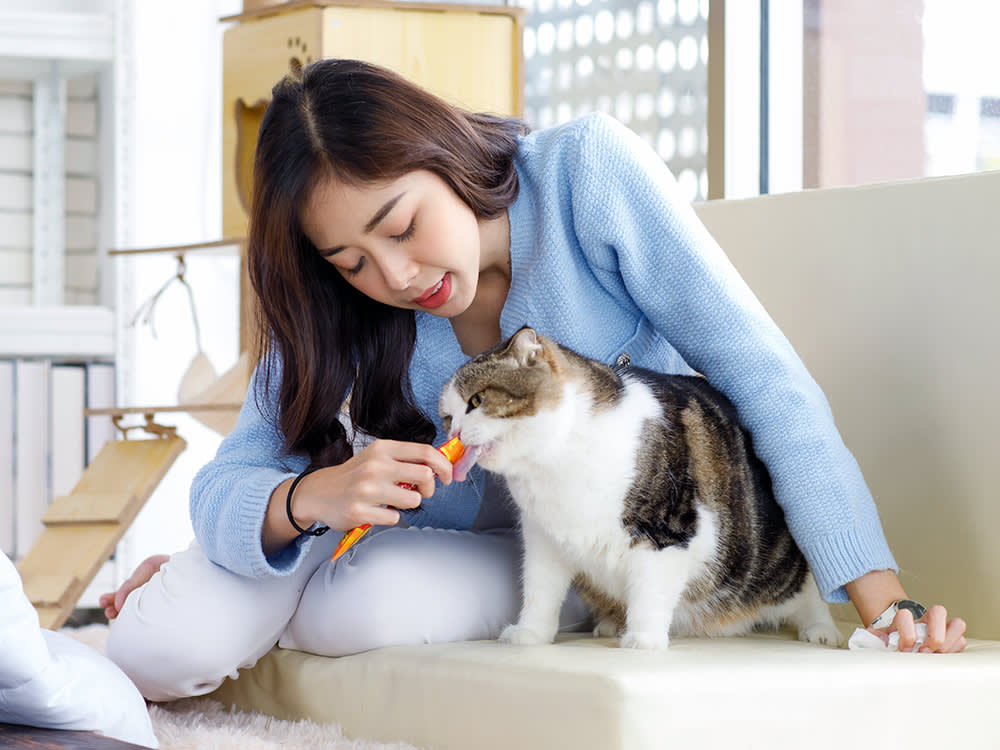
Share Article
While cats may not be known for their voracious appetite, their weight can still be tricky to manage. I say this as the eternally mortified owner of a rather large cat.
Cats have perfected two tactics to manipulate their humans (or should I say servants) into handing over food no matter what time of day it may be. One is their incessant, ear-piercing meow and the other is their irresistible Puss in Boots stareopens in new tab to melt your heart.
Some cats can naturally self-regulate and are fine to be offered food on tap, which they can consume throughout the day whenever they’re ready. Others, will gorge every time they are shown affection and should be given a limited amount of food at set meal times.
If your cat is of the outdoor persuasion, there are added complexities to consider. Not only do they have the entirety of nature’s menu at their disposal, they also have an infinite number of neighbours to whom they can pretend to be homeless and starving. (I remember once looking out of my window and seeing my own cat staring back at me from the upstairs window of my elderly neighbour’s house).
The average neutered, adult cat weighing 5kg requires 250 calories per day. If your cat spends their days performing parkour round the neighbourhood, is un-neutered or has a low body condition score (their version of a BMI), then they will require more than this. Kittens, in particular, require many more calories per day to fuel their growth. Sedentary cats that put weight on just by looking at their bowl, who are a dream away from their fighting weight will require a lower calorie count per day.
How to calculate your cat’s calorie intake
You can discuss the dietary needs of your own pet with your vet, but if you’d like to delve into a bit more arithmetic, then you can work things out at home using the following formula:
The recommended energy requirement of a cat is its bodyweight x 30 + 70. This answer is then multiplied by one of the following numbers depending on your cat’s situation.
neutered adults: 1.2
intact adults: 1.4
obese prone: 1.0
weight loss: 0.8
growing kittens: 2.5
The answer you get will give you the number of calories required per day, so should then be divided by the number of times your cat is fed. This is still a guide only; activity levels and individual genetic makeup will also play a part. The biggest indicator of whether your pet is being fed the right amount of food is their body condition score, if they are overweight gradually reduce their portion sizes and vice versa if the are underweight.
Treats contain calories and are not complete or balanced nutritionally, so should be given in moderation to avoid your cat becoming obese or unhealthy. That’s not to say that treats are always bad but they should make up no more than 10 percent of your cat’s daily intake. If your cat is overweight, treats should be cut out completely until they are back to a healthy size.
The amount of calories contained in food and treats is usually listed on the packaging as kcal/g. Make sure to consider the number of calories fed in treats and reduce your cat’s main meal accordingly to avoid overfeeding them.
Let’s use your average 5kg neutered cat as an example.
They need around 250 calories per day. 25 calories can be given as treats; 225 calories should be given as meals. If your cat is fed twice daily, they should have around 112.5 calories per meal.
You look on the packaging of your cat’s favourite treat. They contain 2kcal per treat. Your cat can therefore enjoy 12 treats per day. Your cat’s regular diet contains 0.73kcal/g, meaning they can have around 150g per meal.
When should I give my cats treats?
No time of day is preferred when it comes to offering treats but they should be given between meals and should ideally serve a purpose such as stress reduction, mental stimulation or training. If your pet is prone to anxiety place them in a quiet room away from any stimuli and offer them a treat they love. Spread treats out throughout the day and give them spontaneously to reduce boredom.
Despite the mythopens in new tab, cats can absolutely be trained if the stakes on offer are high enough. Avoid giving your cat a treat when they’re doing something you don’t like, for example yowling at to the top of their lungs whilst sitting on the kitchen counter watching you cook, or scratching like a demon possessed at the cupboard containing the treats.
In this instance, the treat serves as a reward and the more you reward this behaviour, the more your cat will do it. Instead, reward your cat when they do something you want to encourage. If your cat has a habit of disappearing for days, reward them when they return home. If your cat is prone to putting on weight then create a mini obstacle course and lure your cat around it, rewarding them with a tasty snack at the end. You can take things one step further and train your cat to respond to a clicker; they’ll be the best-behaved kitty in no time.
Which treats are best for my cat?
Not all treats are created equally. When selecting treats look for ones containing a large percentage of high quality protein such as fish or chicken. Treats can also contain ingredients that can be beneficial to your pet’s joints, skin, coat or even their teeth. Treats containing sugar, carbohydrates, salt and fats should kept to a minimum.
You can offer them dry food from their main diet as treats throughout the day. If this doesn’t cut it then consider cooking some fresh unseasoned chicken, turkey, beef, fish or eggs. Just remember to avoid any recipes that suggests using salt, sugars or large volumes or carbohydrates if you’re giving your kitty any leftovers. These still do not form a balanced diet so need to be fed in moderation alongside a complete diet.
Too many sugary treats can have an impact on your cat’s dental hygiene. Believe it or not, cats will tolerate teeth brushing if the concept is introduced slowly, carefully and ideally at a young age. This should be a habit that is done daily using specially designed cat toothbrushes and toothpaste.
In summary, treats are an excellent way to reward good behaviour, teach your cat new tricks and reduce boredom and anxiety. Select treats that contain primarily high quality protein. Remember to reduce the amount you feed your cat accordingly. If your cat is overweight avoid treats for the time being, limit their calorie intake and encourage exercise. Don’t forget to consider what they might be eating elsewhere. If your cat has an underlying health condition, or is particularly over or underweight, discuss their nutrition with the professionals at your local veterinary practice.

Dr Nina Blackmore, MRCVS, BVSc, PgCertSAECC
Nina Blackmore is a vet who, after leaving the Royal Army Veterinary Corps, took up two very different lives. For four long, chaotic days each fortnight she lives in a tiny house next to a small animal veterinary hospital in Boston, managing hospitalised patients and treating any emergency cases that turn up. As well as emergencies she also has a keen interest in pain management and acupuncture. The rest of her time is spent in a quirky bungalow in Rutland where she and her husband run a self sufficient small holding and a dog home boarding business. She spends her life surrounded by animals and has made it her life goal to help as many as possible.
Related articles
![Cat eating out of metal bowl]()
9 Foods You Should Never Feed Your Cat
Sharing isn’t always caring. Keep your cat safe by keeping these human snack staples to yourself
![A woman eating peanut butter toast with her cat laying on the table]()
Can Cats Eat Peanut Butter?
The sweet and salty treat is OK – in moderation
Can Cats Eat Chocolate?
The human favourite should be kept far away from kitties
![Cat laying on his side with catnip around him, on the kitchen table licking his lips.]()
Can Cats Eat Catnip?
They’re definitely pulling for the answer to be an emphatic ‘yes’, but... not so fast
![cat eating sensitive stomach food for cats]()
Do Cat Foods For Sensitive Stomachs Really Help?
Dr Bruce Kornreich explains why going this route isn’t always the answer
![A ginger cat sitting upright against a wall, displaying their white fluffy primordial pouch.]()
Why Does My Cat Have a Primordial Pouch?
A low-swinging belly is totally normal in cats and isn’t usually a cause for concern. So, don’t let your kitty feel ashamed – they’re perfect just as they are


